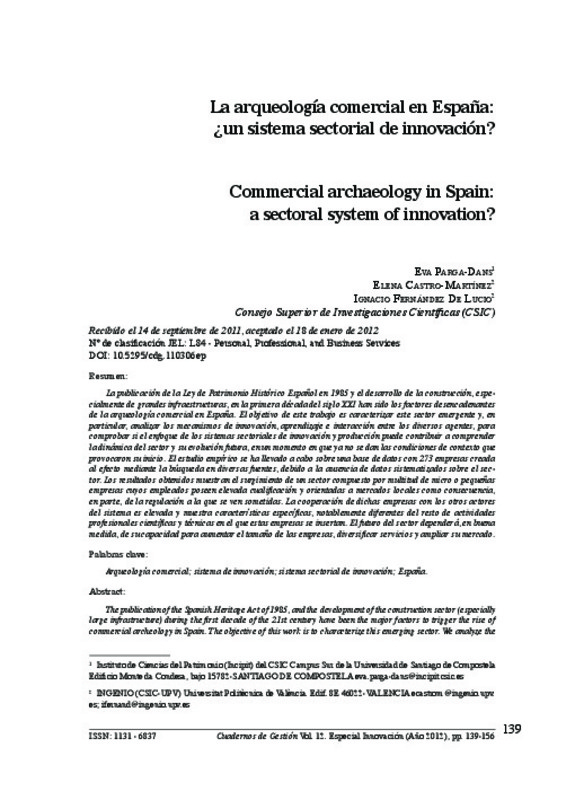JavaScript is disabled for your browser. Some features of this site may not work without it.
Buscar en RiuNet
Listar
Mi cuenta
Estadísticas
Ayuda RiuNet
Admin. UPV
La arqueología comercial en España
Mostrar el registro sencillo del ítem
Ficheros en el ítem
| dc.contributor.author | Parga-Dans, Eva
|
es_ES |
| dc.contributor.author | CASTRO-MARTINEZ, ELENA
|
es_ES |
| dc.contributor.author | Fernandez de Lucio, Ignacio
|
es_ES |
| dc.date.accessioned | 2013-05-14T12:19:32Z | |
| dc.date.available | 2013-05-14T12:19:32Z | |
| dc.date.issued | 2012 | |
| dc.identifier.issn | 1988-2157 | |
| dc.identifier.uri | http://hdl.handle.net/10251/28831 | |
| dc.description.abstract | [ES] La publicación de la Ley de Patrimonio Histórico Español en 1985 y el desarrollo de la construcción, especialmente de grandes infraestructuras, en la primera década del siglo XXI han sido los factores desencadenantes de la arqueología comercial en España. El objetivo de este trabajo es caracterizar este sector emergente y, en particular, analizar los mecanismos de innovación, aprendizaje e interacción entre los diversos agentes, para comprobar si el enfoque de los sistemas sectoriales de innovación y producción puede contribuir a comprender la dinámica del sector y su evolución futura, en un momento en que ya no se dan las condiciones de contexto que provocaron su inicio. El estudio empírico se ha llevado a cabo sobre una base de datos con 273 empresas creada al efecto mediante la búsqueda en diversas fuentes, debido a la ausencia de datos sistematizados sobre el sector. Los resultados obtenidos muestran el surgimiento de un sector compuesto por multitud de micro o pequeñas empresas cuyos empleados poseen elevada cualificación y orientadas a mercados locales como consecuencia, en parte, de la regulación a la que se ven sometidas. La cooperación de dichas empresas con los otros actores del sistema es elevada y muestra características específicas, notablemente diferentes del resto de actividades profesionales científicas y técnicas en el que estas empresas se insertan. El futuro del sector dependerá, en buena medida, de su capacidad para aumentar el tamaño de las empresas, diversificar servicios y ampliar su mercado. | es_ES |
| dc.description.abstract | [EN] The publication of the Spanish Heritage Act of 1985, and the development of the construction sector (especially large infrastructure) during the first decade of the 21st century have been the major factors to trigger the rise of commercial archeology in Spain. The objective of this work is to characterize this emerging sector. We analyze the learning, interaction and innovation mechanisms between various actors, verifying whether the approach of sectoral systems of innovation and production can contribute to understanding industry dynamics and future developments, especially when the contextual conditions that led to the inception of this sector do not exist anymore. The lack of systematic data about the sector led to the search of a variety of sources to develop a companies¿ database. The empirical study on the 273 registered companies was carried out in 2009. Results obtained in the study show the emergence of a sector composed of a great number of micro and small companies, whose employees are both, high skilled and have a strong focus on their local markets. This fact can be regarded as a consequence of the regulations the companies are subject to. Cooperation between the companies mentioned and other actors inside the system is high, and the interaction among them shows specific characteristics, significantly different from the ones observed in the rest of professional scientific and technical business activities. The future of the sector will largely depend on its ability to increasing the size of its companies, and to diversify and expand to other markets. | es_ES |
| dc.language | Inglés | es_ES |
| dc.publisher | Universidad del País Vasco | es_ES |
| dc.relation.ispartof | REVISTA CUADERNOS DE GESTION | es_ES |
| dc.rights | Reserva de todos los derechos | es_ES |
| dc.subject | Arqueología comercial | es_ES |
| dc.subject | Sistema de innovación | es_ES |
| dc.subject | Sistema sectorial de innovación | es_ES |
| dc.subject | España | es_ES |
| dc.subject | Commercial archeology | es_ES |
| dc.subject | Innovation system | es_ES |
| dc.subject | Sectoral innovation system | es_ES |
| dc.subject | Spain | es_ES |
| dc.title | La arqueología comercial en España | es_ES |
| dc.title.alternative | Commercial archaeology in Spain: a sectoral system of innovation? | es_ES |
| dc.type | Artículo | es_ES |
| dc.identifier.doi | 10.5295/cdg.110306ep | |
| dc.rights.accessRights | Abierto | es_ES |
| dc.contributor.affiliation | Universitat Politècnica de València. Instituto de Gestión de la Innovación y del Conocimiento - Institut de Gestió de la Innovació i del Coneixement | es_ES |
| dc.description.bibliographicCitation | Parga-Dans, E.; Castro-Martinez, E.; Fernandez De Lucio, I. (2012). La arqueología comercial en España. REVISTA CUADERNOS DE GESTION. 12(2):139-156. doi:10.5295/cdg.110306ep | es_ES |
| dc.description.accrualMethod | S | es_ES |
| dc.relation.publisherversion | http://dx.doi.org/10.5295/cdg.110306ep | es_ES |
| dc.description.upvformatpinicio | 139 | es_ES |
| dc.description.upvformatpfin | 156 | es_ES |
| dc.type.version | info:eu-repo/semantics/publishedVersion | es_ES |
| dc.description.volume | 12 | es_ES |
| dc.description.issue | 2 | es_ES |
| dc.relation.senia | 208762 |








